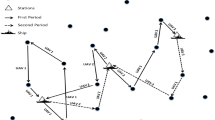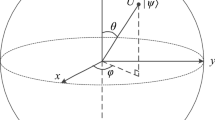Abstract
The general problem of path planning can be modeled as a traveling salesman problem which assumes that a graph is fully connected. Such a scenario of full connectivity is however not always realistic. One such motivating example for us is the application of path planning for unmanned reconnaissance aerial vehicles (URAVs). URAVs are widely deployed for photography or imagery gathering missions of sites of interest. These sites can be targets in a combat zone to be investigated or sites inaccessible by ground transportation, such as those hit by forest fires, earthquake or other forms of natural disasters. The navigation environment is one where the overall configuration of the problem is a sparse graph. Unlike graphs that are fully connected, sparse graphs are not always Hamiltonian. In this paper, we describe hybrid ant colony algorithms (HACAs) proposed for path planning in sparse graphs since existing ant colony solvers designed for solving TSP do not apply to the present context directly. HACAs represent ant inspired algorithms incorporated with a local search procedure and some heuristic techniques for uncovering feasible route(s) or path(s) in a sparse graph within tractable time. Empirical results conducted on a set of generated sparse graphs demonstrate the excellent convergence property and robustness of HACAs in uncovering low risk and Hamiltonian visitation paths. Further, the obtained results also indicate that HACAs converge to secondary closed paths in situations where a Hamiltonian cycle does not exist theoretically or is not attainable within the bounded computational time window.
Similar content being viewed by others
References
Agarwal A, Lim MH, Xu YL, Ong YS (2003) Evolutionary graph mining for the discovery of site visitation sequences for a single URAV. 2nd International conference on computational intelligence, robotics and autonomous systems, 2003
Agarwal A, Lim MH and Er MJ (2004a). Model-solution framework for minimal risk planning for URAVs. Military and security applications of evolutionary computation workshop. GECCO, Seattle, USA
Agarwal A, Lim MH, Chew CY, Poo TK, Er MJ, Leong YK (2004b) Solution to the fixed airbase problem for autonomous URAV site visitation sequencing. In: Proceedings of genetic and evolutionary computation conference, Seattle, vol 2, USA, pp 850–858
Agarwal A, Lim MH, Er MJ, Maung YWK (2004c) Inflight rerouting for an unmanned aerial vehicle. In: Proceedings of genetic and evolutionary computation conference, Seattle, vol 2, USA, pp 859–868
Agarwal A, Lim MH, Er MJ and Nguyen TN (2007). Rectilinear workspace partitioning for parallel coverage using multiple UAVs. Adv Robot 21(1–2): 105–120
Bullnheimer B, Hartl RF and Strauss C (1999). Applying the ant system to the vehicle routing problem. In: Voss, S, Martello, S, Osman, IH, and Roucairol, C (eds) MetaHeuristics: advances and trends in local search paradigms for optimization, Kluwer, Boston
Christofides N, Mingozzi A and Toth P (1979). The vehicle routing problem. In: Christofides, N, Mingozzi, A, Toth, P, and Sandi, C (eds) Combinatorial optimization, pp 315–338. Wiley, Chichester
Coello CAC, Gutièrrez RLZ, García BM and Aguirre AH (2002). Automated design of combinational logic circuits using the ant system. Eng Optim 34(2): 109–127
Colorni A, Dorigo M, Maniezzo V and Trubian M (1994). Ant system for Job-Shop Scheduling. Belg J Oper Res Stat Comput Sci 34(1): 39–53
Di Caro G and Dorigo M (1998). AntNet: Distributed stigmergetic control for communications networks. J Art Intell Res 9: 317–365
Dorigo M, Caro GD and Gambardella LM (1999). Ant algorithms for discrete optimization.. Art Life 5(2): 137–172
Dorigo M and Gambardella LM (1997a). Ant colony system: a cooperative learning approach to the traveling salesman problem. IEEE Trans Evol Comput 1(1): 53–66
Dorigo M and Gambardella LM (1997b). Ant colonies for the traveling salesman problem. BioSystems 43: 73–81
Flood MM (1956). The traveling salesman problem. Oper Res 4: 61–75
Forsyth P and Wren A (1997). An ant system for bus driver scheduling. 7th International workshop on computer-aided scheduling of public transport. Boston, USA
Gambardella LM, Taillard E and Dorigo M (1999). Ant colonies for the quadratic assignment problem. J Oper Res Soc 50: 167–176
Gambardella LM and Dorigo M (1997). HAS-SOP: an hybrid ant system for sequential ordering problem. Technical report no IDSIA 97–11. Lugano, Switzerland
Goss S, Beckers R, Deneubourg JL, Aron S, Pasteels JM (1990) How Trail laying and trail following can solve foraging problems for ant colonies. In: Hughes RN (ed) NATO-ASI series behavioral mechanisms of food selection
Gross J, Yellen J, Raton B (1999) Graph theory and its applications: CRC Press series on Discrete Mathematics and its Applications, ISBN: 0849339820
Laporte G, Vaziri AA and Srikandarajah C (1996). Some applications of the generalized travelling salesman problem. J Oper Res Soc 47: 1461–1467
Labordere ALH (1969). The record balancing problem: a dynamic programming solution of a generalized traveling salesman problem. RIBO B-2: 736–743
Lim MH, Yuan Y and Omatu S (2002). Extensive testing of a hybrid genetic algorithm for solving quadratic assignment problems. Comput Optim Appl 23: 47–64
Lin S and Kernighan B (1973). An effective heuristic algorithm for the traveling salesman problem. Oper Res 21(2): 498–516
Maniezzo V and Colorni A (1999). The ant system applied to the quadratic assignment problem. IEEE Trans Knowl Data Eng 11(5): 769–778
Ong YS and Keane AJ (2004). Meta-Lamarckian learning in Memetic Algorithm. IEEE Trans Evol Comput 8(2): 99–110
Ong YS, Lim MH, Zhu N and Wong KW (2006). Classification of adaptive Memetic algorithms: a comparative study. IEEE Trans Syst, Man Cybern Part B, 36(1): 141–152
Sandalidis HG, Mavromoustakis K and Stavroulakis P (2001). Performance measures of an ant based Decentralised routing scheme for circuit switching communication networks. Soft Comput A Fusion Found Meth Appl 5(4): 313–317
Schoonderwoerd R, Holland O, Bruten J and Rothkrantz L (1997). Ant-based load balancing in telecommunications networks. Adap Behav 5(2): 169–207
Stützle T, Hoos H (1997) The max–min ant system and Local search for the traveling salesman problem. In: Proceedings of the 4th IEEE international conference on evolutionary computation, IEEE Press: 308–313
Ying KC and Liao CJ (2004). An ant colony system for permutation flow-shop sequencing. Sour Comput Oper Res Arch 31(5): 791–801
Sparse Graphs, http://www.ntu.edu.sg/home/asysong/sparse/default.htm
University of Heidelberg, Department of Computer Science. http://www.iwr.uni-heidelberg.de/groups/comopt/software/TSPLIB95
Author information
Authors and Affiliations
Corresponding author
Rights and permissions
About this article
Cite this article
Lim, K.K., Ong, YS., Lim, M.H. et al. Hybrid ant colony algorithms for path planning in sparse graphs. Soft Comput 12, 981–994 (2008). https://doi.org/10.1007/s00500-007-0264-x
Published:
Issue Date:
DOI: https://doi.org/10.1007/s00500-007-0264-x




